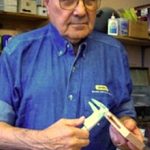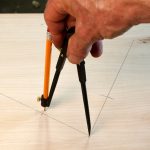We may receive a commission when you use our affiliate links. However, this does not impact our recommendations.
 Hello out there in hand tool world; it is I, your stealthy neighborhood SawWright, Matt Cianci!
Hello out there in hand tool world; it is I, your stealthy neighborhood SawWright, Matt Cianci!
I have risked life and limb by hacking into the PopWood blog to further propogate my twisted brand of saw-speak. And while I’m at it, I’ll answer some common questions about my latest DVD “Build A Custom Backsaw.” The following are some of the common questions that I have received by e-mail, blog comments and, yes, even…(gasp)…online forums! Don’t hate. 🙁
Question: In the video, you state that you can feel the back seat as you drive it onto the saw plate. What do you mean by this and should I seat the back fully and drive it all the way into the slot?
Answer: You should not drive the saw plate all of the way into the back slot so that it bottoms out in the back. If you do, it will almost always warp the toothline. I use the term “seat” not very accurately here…what I mean to say is that I can feel when the back reaches the correct depth. The goal is to drive the back on almost all of the way, but leave a small amount of depth in the slot for adjustment.
 Question: In the video you demonstrate cutting the back mortise before laying out and cutting the cant on the saw plate. Wouldn’t it make more sense to lay out and cut the cant before cutting the back mortise, so that the bottom of the mortise is parallel with the saw back?
Question: In the video you demonstrate cutting the back mortise before laying out and cutting the cant on the saw plate. Wouldn’t it make more sense to lay out and cut the cant before cutting the back mortise, so that the bottom of the mortise is parallel with the saw back?
Answer: Absolutely yes. This is the one glaring goof on my part in the video. You should reverse this operation and not cut the back mortise in the tote until you have the saw plate and back cut to their final shapes and assembled. No idea how I missed this in the editing, but I’m going to blame this on David Thiel. Or, better yet, let’s blame Tom Nunlist…he’s leaving for China anyway and will never see the Western world again. 😉
Question: Can you give me some advice on sanding and finishing the tote?
Answer: There is no wrong way to finish a saw tote, as long as you don’t paint it, in my opinion. My preferred method for finishing totes is very simple. I sand with #120, #220 and #400 grit, followed by a good coat of boiled linseed oil. For my own saws, I simply let the oil dry and apply paste wax with Liberon #0000 steel wool. Then buff by hand. This gives a smooth, tactile finish that just gets better looking with age. For a little more protection and bling, I apply two light coats of amber shellac after the oil, then wax. I don’t like polyurethane or varnish because of the plastic look they impart, but you should feel confident in using any finish you like.
Question: I like to work from scratch to maximize my understanding of the raw materials and am very frugal with woodworking projects (read: I’m a cheapskate with control issues). Can you give me some guidance on fabricating the saw parts on my own?
Answer: There is a ton of info available on the web about fabricating your own saw parts. You can mill a back from brass bar stock on a drill press equipped with a slot cutter, or you can fold your own back from mild steel stock available from any home center. You can get small quantities of 1095 spring steel saw plate materials from industrial suppliers including MSC and McMaster-Carr. You can even fabricate your own traditional split-head saw bolts and nuts from brass stock.
For more info, check out two of my favorite saw makers:
Norse Woodsmith and Blackburn Tools.
Question: Can you tell me more about the kind of rasps and files you use for shaping the tote? What sizes and grain stitching do you recommend?
Answer: I use several hand-stitched rasps when shaping saw totes. First is an 11-grain, 8″ cabinetmakers half-round rasp. This is indispensable for the initial shaping of the tote outline. Next, a 13-grain 6″ modeler’s half-round rasp is used to refine all of the surfaces and aesthetic details. Finally, a 6″ saw-handle maker’s rasp in 11 grain for shaping the roundovers on the grip, followed by a 13 grain to blend and smooth the transitions. Final smoothing is done with a half-round cabinet file over all of the surfaces. If I had to pick only one, I’d say the modeler’s rasp would be the most adept at performing most of these tasks, followed by the handle-maker’s rasp.
Feel free to e-mail me directly with more questions or comments at matt@thesawwright.com
And keep an eye out for my next DVD with Popular Woodworking, “Super-Tune a Backsaw” – coming soon.
Keep makin’ saw dust!
— Matt Cianci
Here are some supplies and tools we find essential in our everyday work around the shop. We may receive a commission from sales referred by our links; however, we have carefully selected these products for their usefulness and quality.











I’ve made a few back saws and hand saws from scratch out of blue tempered shim stock and they work great. A trick for cutting the stuff is to use a diamond masonry blade. It cuts like butter and doesn’t even get hot.
On a recent trip to the big box store I found a blue steel taping knife in the paint section begging to be re-purposed into a back saw. It’s the right size and shape, has a back on it already and only $9 with no shipping.
Matt,
Great to see you here! As soon as they fix the darned VIP program, I’m ordering your videos. Meant to do it when i went home, but you know how it is – one second your there, the next you’re waving goodbye to the family from the terminal tram…
Stay safe Brother!
Albert
— You should not drive the saw plate all of the way into the back slot so that it bottoms out in the back. If you do, it will almost always warp the toothline. —
Matt, another way to deal with this phenomenon is to file the top edge of the blade slightly convex. Assuming the slot is of uniform depth and that it is not bowed concave on the slotted side (fairly safe assumptions if the slot was properly cut), then the blade can be fully seated without warping the blade.